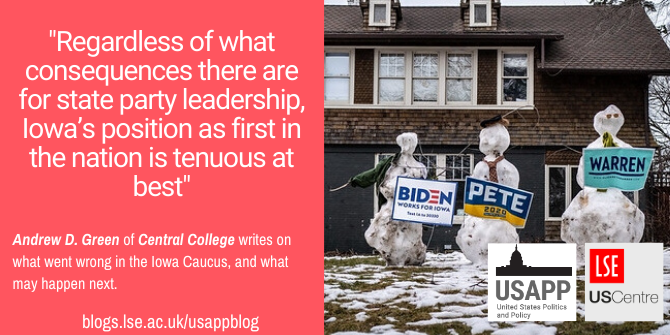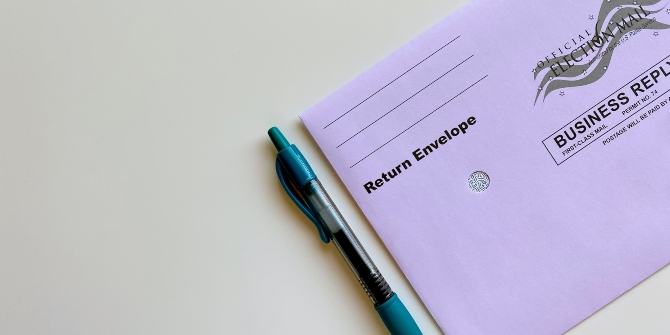 Instead of enabling a candidate to declare victory and gain momentum ahead of the presidential primary contests to follow, the 2020 Iowa Democratic Caucus was beset by technological problems that drastically delayed the announcement of the results. Andrew D. Green reports on the caucus experience from on the ground and discusses the implications for the Democratic candidates for the next stages of the presidential primary race.
Instead of enabling a candidate to declare victory and gain momentum ahead of the presidential primary contests to follow, the 2020 Iowa Democratic Caucus was beset by technological problems that drastically delayed the announcement of the results. Andrew D. Green reports on the caucus experience from on the ground and discusses the implications for the Democratic candidates for the next stages of the presidential primary race.
- This article is part of our Primary Primers series curated by Rob Ledger (Frankfurt Goethe University) and Peter Finn (Kingston University). Ahead of the 2020 election, this series explores key themes, ideas, concepts, procedures and events that shape, affect and define the US presidential primary process. If you are interested in contributing to the series contact Rob Ledger (ledger@em.uni-frankfurt.de) or Peter Finn (p.finn@kingston.ac.uk).
The 2020 Iowa Caucus will long be recalled for what occurred hours after tens of thousands of Iowa Democrats gathered in community centers, churches, and schools around the state. The tragedy of the whole experience is that many caucus goers walked away from their caucus sites extremely happy with how the caucuses were run and excited to learn how their preferred candidate(s) fared around the state. What ultimately will be remembered, however, are the technological reporting failures that prevented the Iowa Democratic Party (IDP) from reporting the results in a quick and efficient manner. Considering that there were already calls for the Democratic National Committee (DNC) to reconsider Iowa as the starting point for the 2024 presidential nomination cycle, the technological failures will only serve to fuel the flames of reform and change.
Reflections from a Precinct Caucus Participant
On Monday, I caucused in the unincorporated community of Otley, Iowa, which is approximately 35 miles southeast of Des Moines. The rural precinct location hosted 80 registered Democrats from Rock Rapids and Summit Townships. The mood in the room was upbeat and positive. As the crowd gathered, friends and neighbors, along with newcomers to the precinct, chatted with one another about the state of the race and current events, but also about their local communities and neighborhoods. In that way, the caucuses were an opportunity for folks to gather and build social capital.
Most participants were assembled in their candidate preference groups when the caucus commenced. As a result, the first preference alignment went quickly. Consistent with what was observed at many rural precincts, former Mayor Pete Buttigieg led the precinct with 23 votes after the first alignment, followed by 15 for Senator Amy Klobuchar, 14 each for former Vice President Joe Biden and Senator Bernie Sanders, and 10 for Senator Elizabeth Warren. Andrew Yang was the only other candidate to receive votes (3). The “viability threshold” of 15 percent meant that a candidate had to have at least 12 votes to remain viable.
During the realignment period, the Warren group was unable to secure an additional two votes, so their group, along with the Yang group, were not viable after the second alignment. The supporters of non-viable candidates were then required to realign with another candidate, remain in the group of the first choice and receive no delegates, or declare themselves uncommitted. In the end, Buttigieg increased his vote share by three votes and received two delegates to the Marion County Democratic Convention in March. Klobuchar ended up in second with 19 votes, but also received two delegates to the county convention. Sanders and Biden ended in third and fourth place with 18 and 14 votes respectively, and each group was awarded one delegate for the county convention. Only three voters were uncommitted after the second alignment.
In full disclosure, this was my first Democratic caucus as an Iowan. While I have taught students about the process over and over again, I had never seen it done in person. From my vantage point, the volunteer precinct chair and secretary did an excellent job administering the business of the caucus. Instructions were clear. Adequate time was allowed for alignment and realignment. Preference cards were filled out and collected at the appropriate times. And the allocation of delegates based upon preference alignments was done quickly and efficiently. It was a very positive experience and I left the caucus location feeling upbeat and was enthused to see the final results statewide.
The Technological Issues
It became clear between 9 and 10 PM local time that something was wrong with the reporting of caucus results by the state party. Even though the party would be reporting three sets of data for the first time (e.g., the results of the first alignment, the final vote, and the “state delegate equivalents”), expectations were that the use of a smartphone app to submit precinct results to the state party would make the process of getting results to the people of Iowa and beyond much faster. In response to questions regarding security and the potential for technological glitches, IDP officials assured the public that the app had been tested and would be secure.
It is now clear that there were multiple problems with the app itself. Some precinct officials had problems downloading the app in the first place. Others had difficulty logging into the app on caucus night or the app simply failed on them when they attempted to report results to the state party. Ultimately, IDP Chair Troy Price explained to the media on the day after the caucuses that a “coding error” was responsible for the app failing.

“House Divided” by Phil Roeder is licensed under CC BY 2.0
On top of the technological issues with the app, many precinct officials never had any intention of using the app to submit precinct results because they were not comfortable using it or found it confusing. Instead, they intended to phone in their results to state party headquarters just as they had in the past. The result was an overloading of the state party telephone hotline and a significant delay in reporting the caucus results. Fortunately, IDP instituted the use of “preference cards” in this year’s caucuses, which created a “paper trail” for the party to guarantee accuracy in the reporting of caucus outcomes.
The Implications of the 2020 Iowa Caucuses
So, what does this all mean politically for the candidates as they move to New Hampshire and beyond? Generally, Iowa’s role in the process is not to serve as a “king maker” but to help narrow the range of candidates as the process moves east to New Hampshire and South Carolina. Research on the caucuses indicates that a good showing in Iowa will help build momentum moving forward. Additionally, strong performers in the Iowa Caucuses are often rewarded with media coverage, which can help shape public opinion and potentially vote share in subsequent primaries.
Initial statewide returns (with approximately 71 percent of precincts reporting) reveal a two-way race at the top of the caucus field. Bernie Sanders leads the first alignment (24.4 percent) and final alignment (26.2 percent) counts. Pete Buttigieg is a close second in the final alignment count at 25.2 percent. Yet Buttigieg leads the state delegate equivalent count by 1.6 percent over Sanders (26.8 percent to 25.2 percent). If the result stands as the remainder of the results are verified and reported, it will lead to an opportunity for both campaigns to declare victory in the Iowa Caucuses.
In the context of past research covering the Iowa Caucuses, however, the claim of victory may not have the same effect on subsequent states that previous victories have. While support for Bernie Sanders met expectations on caucus night, Pete Buttigieg exceeded expectations. His Real Clear Politics poll average prior to the caucuses was 16.8 percent. If his vote share remains near 25 percent, his overperformance of expectations in the caucuses could help build momentum as he moves forward. Similarly, Joe Biden’s underperformance in Iowa could hurt him down the road. Biden’s poll average was 19.3 percent prior to the caucuses, but some Iowa polls showed his support in the low to mid-20s. If results hold, Biden will end up with approximately 13 percent of the final alignment count and just over 15 percent of the state delegate equivalents. In a typical caucus cycle, past studies have shown that overperformance and underperformance can shape subsequent races. Due to the inability of the IDP to report the results quickly, it is unclear whether Buttigieg’s overperformance and Biden’s underperformance will be considered by New Hampshire voters.
Additionally, none of the top five candidates in Iowa have dropped out of the race, suggesting that the “winnowing” effect of the Iowa Caucuses may not be present. In fact, the technological problems with reporting caucus results and the resulting delays have allowed fourth and fifth place candidates Joe Biden and Amy Klobuchar to move on from Iowa and hope to successfully build momentum in New Hampshire regardless of the outcome in Iowa. The result may be a scenario where the field significantly narrows after New Hampshire next week or even South Carolina on February 29th, giving candidates in the middle of the pack or lower an opportunity to continue their candidacies a little bit longer.
The longer-term effect of the technological reporting issues centers on Iowa’s role in the nominating process. As mentioned above, there were calls for reform and change not only from political scientists and media pundits, but also from presidential candidates in the leadup to the caucuses. Those calls have been amplified by the inability of the IDP to report the results in a timely manner. While national-level forces continue to criticize Iowa and the caucus process, Ira Lacher, a precinct official from Des Moines, argues that Iowa Democrats “should demand a reckoning from their party leaders.” Regardless of what consequences there are for state party leadership, Iowa’s position as first in the nation is tenuous at best. It is too early to tell whether the Democratic National Committee will change the process for the next presidential election in 2024, but the disaster of the last couple of days certainly does not help make the case for the process starting in Iowa again.
Please read our comments policy before commenting.
Note: This article gives the views of the author, and not the position of USAPP – American Politics and Policy, nor of the London School of Economics.
Shortened URL for this post: http://bit.ly/38avprC
About the author
 Andrew D. Green – Central College
Andrew D. Green – Central College
Andrew D. Green is a Professor of Political Science at Central College in Pella, IA. Dr. Green completed his BA in political science at Wartburg College (IA) and his PhD in political science at The University of California, Riverside. His research focuses primarily on state and local politics and policy, and he has been published in journals such as State Politics and Policy Quarterly, State and Local Government Review, and California Journal of Politics and Policy. Dr. Green is also the author of From the Iowa Caucuses to the White House: Understanding Donald Trump’s 2016 Electoral Victory in Iowa, a book published in August 2019.






